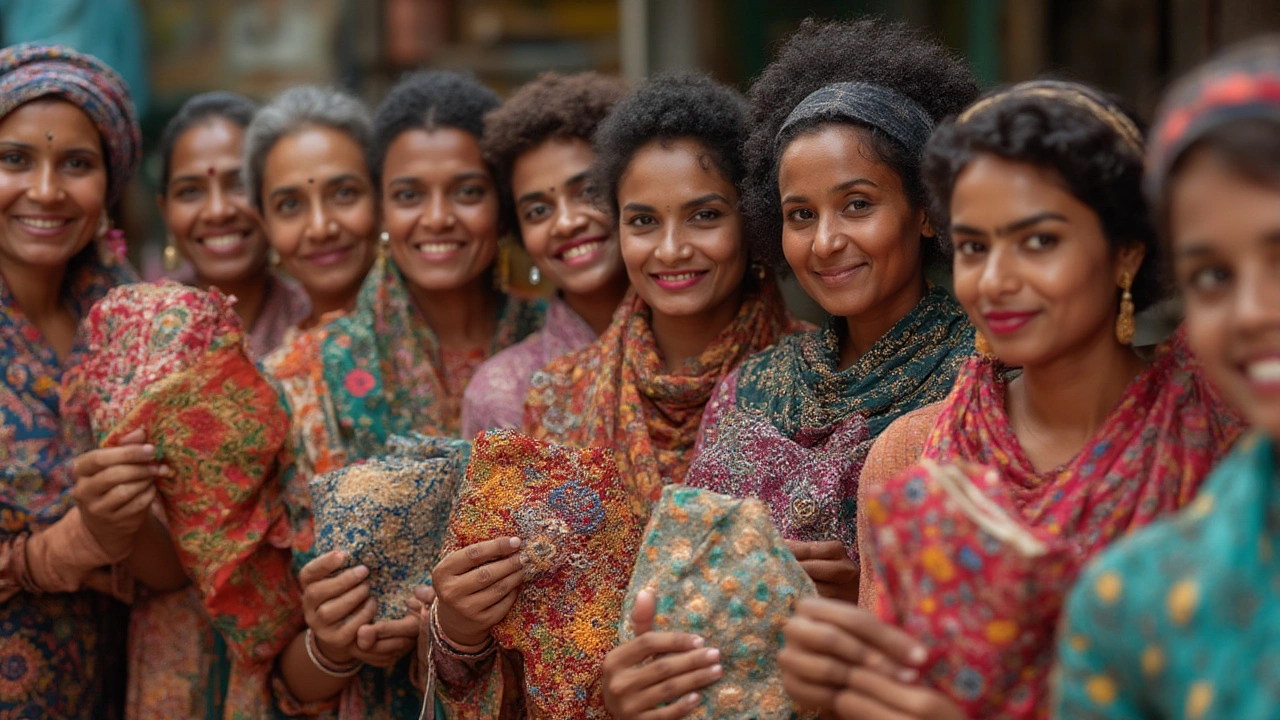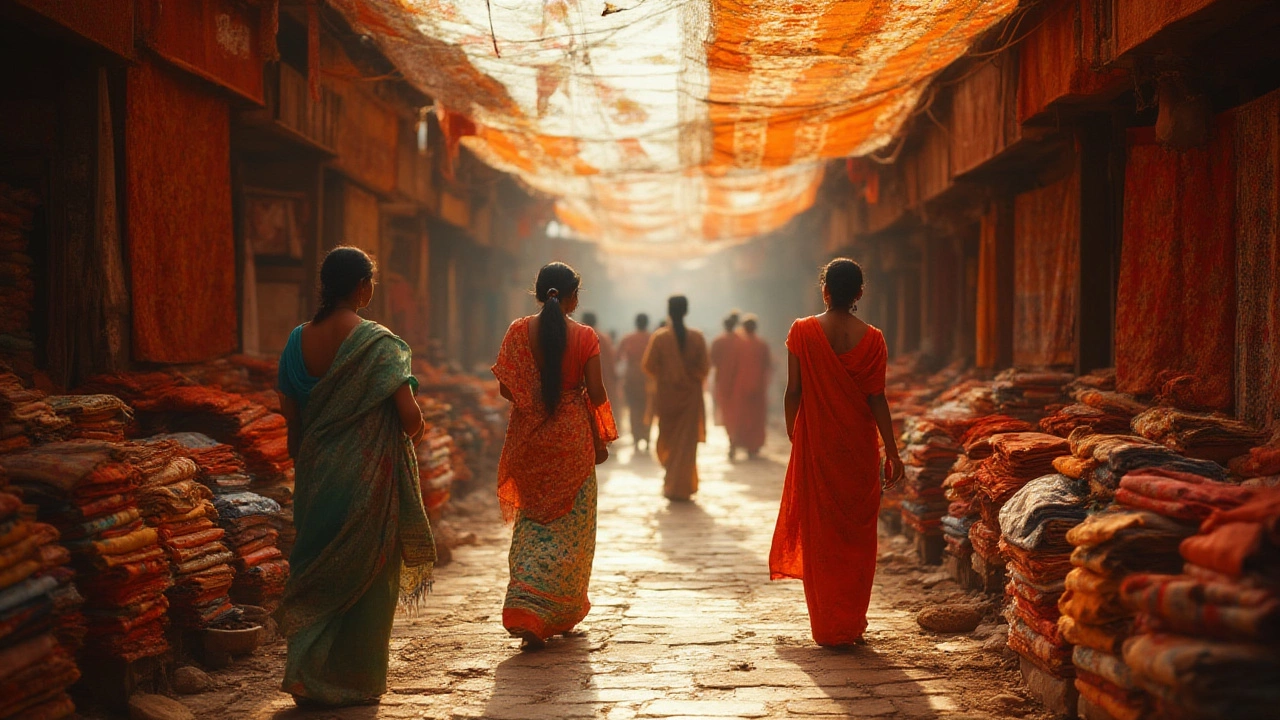Silk saree draped over a grandmother’s arm, the cool texture of a cotton kurta, or the whisper of chiffon at a wedding: fabric is everywhere in India, and the choices are as colorful as the country itself. But ask anyone at a tailor’s counter in a bustling Delhi market in July 2025, and chances are they’ll agree—cotton has never struggled for the top spot. The real twist? The fabric scene is shifting faster than an auto weaving through city traffic. The reasons aren’t just about comfort or tradition, but price hikes, climate, fashion trends, and even tech-driven textile fads. Let’s pull back the curtain and see which fabrics are ruling India today, why, and what you’ll spot more of in your next shopping spree.
India’s Demand for Fabric: Why Cotton Still Rules and What’s Rising
Step into any Indian household, and you’ll discover wardrobes bursting with cotton—from crisp formal shirts to faded night pajamas. For decades, cotton has topped the charts. And it’s not hard to see why: friendly on the skin, handles the heat, soaks up sweat—perfect for tropical summers that stretch longer every year. According to the Ministry of Textiles, 2024 saw India produce over 5.8 million metric tons of raw cotton, making the country the world’s largest cotton producer, a nose ahead of China. More than 45% of all fabric consumed in India is made from cotton, and it’s not only households; the apparel industry, uniform makers, and even export houses keep cotton king.
But in 2025, the cotton story isn’t just about tradition. It’s now about technology too. Think ‘organic cotton’: over 30% of branded ready-made garments are labelled organic or sustainable cotton, according to 2025 retail figures. The younger crowd, especially Gen Z and millennials, is asking for eco-friendly labels. Major brands like FabIndia and Raymond have doubled their range of sustainable-cotton products. Even small-town tailors now offer organic cotton options, with some states giving subsidies for homegrown cotton.
Still, the cotton throne has challengers. From the high-glamour avenue, artificial fabrics like polyester are surging, especially post-pandemic. Loungewear boomed in 2022-23, and in 2024, athletic wear sales—mostly polyester and blends—grew by 30%, as per the Indian Apparel Council. Blended fabrics (like polycotton) have almost doubled their share in the budget-ready-made clothing segment this year, as they’re easy-care, less likely to wrinkle, and cost less than pure cotton.
Silk, the old favorite during festivals and weddings, grabs headlines for another reason: handloom and traditional weaves. India’s silk exports touched $3.8 billion in FY 2024, with key states like Karnataka, Andhra Pradesh, Tamil Nadu, and Assam pushing up output. Sarees, stoles, and even men’s festive wear in Mysore, Banarasi, and Kanchipuram silk keep silk on the top shelf, even if everyday demand is lower than cotton or synthetics.
If you peek into fast fashion stores in shopping malls, you’ll see racks full of viscose and rayon. These semi-synthetic fibers mimic the flow of silk but come cheap and are much less fussy in the wash. According to a recent survey from India Today (June 2025), nearly one in four urban buyers picks viscose-blends for indo-western styles and daily wear, especially in the 18–35 age group.
Here’s a breakdown of market share for key fabrics in India as of July 2025:
| Fabric | 2025 Estimated Market Share (%) | Main Uses |
|---|---|---|
| Cotton | 46 | Daily wear, kids' wear, formals, bedsheets |
| Polyester & Blends | 22 | Loungewear, uniforms, western garments |
| Silk | 11 | Sarees, dresswear, luxury, festive |
| Viscose/Rayon | 13 | Western tops, dresses, fusion wear |
| Linen | 4 | Summer wear, shirts, sarees |
| Wool | 2 | Winter-wear, shawls, exclusive sarees |
| Others (Denim, Jute, Bamboo, etc.) | 2 | Jeans, eco-friendly goods |
Handicraft or artisanal fabric hasn’t been left behind. Khadi, once Gandhi’s protest symbol, is up by 12% in annual demand since 2022, especially with young urban shoppers wanting locally-made and ethically sourced fabrics. PMEGP data shows nearly 6 lakh artisans working in khadi and handloom in 2025. But khadi and handlooms still form a tiny wedge in the grand pie, mostly limited by price and weaker supply chains.

Fashion, Climate, and Cost: What Shapes Fabric Choices in India
Fabric isn’t just a personal choice in India. It’s decided by geography, climate, government policy, your wallet, and the movies you watch. In the north, especially in states like Punjab, Delhi, and Uttar Pradesh, demand for wool surges from November to March. But don’t expect wool to appear in Rajasthan or Tamil Nadu’s lanes in May—there, cotton and airy blends rule. Humidity in the east (think Bengal, Odisha, Assam) keeps linen and light cotton popular, especially with weaves like Bengal mul or Assam muga silk.
Pricing is a huge factor. Last year, the price of imported polyester and viscose went up by 8%, thanks to currency swings and global supply chain hiccups. Meanwhile, cotton prices were more steady, helped by government-backed Minimum Support Price (MSP) schemes. This had an impact on what small brands, tailors, and mass retailers stocked. If you’ve visited a street market in Kolkata or Chennai in the last six months, you’d have seen more polycotton—and less pure imported rayon—than the year before.
Fashion trends are contagious in India. A hit TV show or Bollywood release decides what people want. After a leading actress wore a pastel linen saree in a summer blockbuster this year, linen sarees zipped up by 17% in online sales over three months, especially among urban shoppers. But price keeps linen niche; most people shift back to cotton or polycotton post-trend. Meanwhile, platform economy apps like Myntra and Ajio are driving up demand for synthetic blends and affordable occasion-wear, which often means cheaper polyester-based party dresses and printed shirts.
Another angle is the rise of functional and technical fabrics. With the fitness wave sweeping middle-class India, fabric makers are developing ‘moisture-wicking’ polyester knits and spandex blends. Gymgoers and runners reach for these materials more, and sportswear brands in India now source over 70% of their activewear fabric from local synthetic suppliers. According to the Indian Texpreneurs Federation, the value of India’s sports and activewear fabrics segment crossed INR 42,000 crore in 2024, more than double the pre-pandemic figure.
Eco-conscious consumers want more than just a nice-looking garment. The demand for recycled polyester, bamboo fiber fabric, and sustainable blends is spiking—albeit in metro cities and among financially comfortable buyers. Several D2C brands in 2025 now market upcycled garments, transparent supply chains, and “zero harmful chemicals” as their big selling points. Fashion week collections in Delhi and Mumbai this year featured handloom cotton, Tencel, modal, and ‘peace silk’ (cruelty-free silk), supporting the growing green trend.
So, what about men’s fashion? Honestly, it’s changing fast too. My own last shirt shopping trip with Priya had us trying to figure out if the linen shirt I liked was real linen or just a smooth cotton blend. The salesperson explained how most budget men’s formal shirts in India now secretly blend polyester for better crease resistance. Still, pure cotton gets picked more for everyday comfort, highlighting how habits and practicality still lead.
This diverse mix means the answer to “which fabric is in most demand?” depends on who you are and where you shop. But the pecking order is clear: cotton for hot, humid living; polyester blends for easy care and gyms; silks and viscose for special days; linen when you want to feel fancy, and wool for winter chills in the north. Price tags and weather rule just as much as trends and tradition.

Tips for Choosing Fabrics in 2025: Know the Trends, Spot the Fakes, Shop Smart
If you’re feeling overwhelmed by all the options, you’re not alone. Here’s a cheat sheet for navigating India’s bustling fabric markets and online stores this year:
- Look for GSM (Grams per Square Meter) on cotton labels. Lightweight (about 120–150 GSM) is best for Indian summers. Heavier is for upholstery or winter shirts.
- Polyester blends resist wrinkles but can get sweaty. For daily office wear, polycotton is easier to wash and cheaper. If you’re prone to skin allergies, pure cotton is safer.
- Linen has best breathability, which is a blessing in humid weather. But it creases quickly and costs more. Women’s linen kurtas are everywhere in 2025, but check labels; many are just cotton blends sold as “linen look.”
- Watch out for fake silk, which is often polyester with a shiny finish. The “burn test”—where a fabric edge is burned (under safe conditions)—is still a classic at many family-owned stores: real silk smells of burning hair, polyester like burnt plastic.
- If you want pure khadi or handloom, look for the government-certified “Khadi” tag—knock-offs are common, even online.
- Don’t skip the “wash care” label. Synthetic blends may pill or lose shape in the machine, while real silk and pure wool always need dry cleaning.
- Online shoppers: Stick to major brands or platforms with clear return policies. Counterfeit or mislabelled fabric is a growing headache in India’s online market, as per the Consumer Protection Council.
- For sustainable choices, check for certifications like GOTS (for organic cotton) or OEKO-TEX (for chemical safety). This is especially important if you or your kids have sensitive skin.
- Want a cool monsoon hack? Avoid viscose and rayon during prolonged rains—they soak up moisture, get heavy, and may even shrink.
- Think of climate, use, and budget—don’t just go with trends. A pure linen kurta is amazing for a special event, but budget cotton works better for daily wear and laundry stress.
Fabric demand in India shifts as fast as Bollywood haircuts. The big takeaway? For daily, affordable, and comfy clothes, cotton still rules, but blends and synthetics are catching up, thanks to changing lifestyles and smart innovations from India’s booming textile sector. Special occasions are still the turf of silk, linen, and luxury blends. As India gets richer and more style-conscious, you can bet on one thing—next year’s hottest fabric might be on a loom somewhere right now, waiting to become everyone’s next wardrobe favorite.
